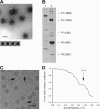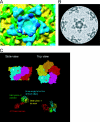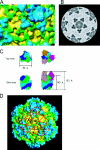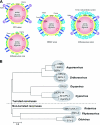Structural evolution of reoviridae revealed by oryzavirus in acquiring the second capsid shell
- PMID: 18787002
- PMCID: PMC2573255
- DOI: 10.1128/JVI.02375-07
Structural evolution of reoviridae revealed by oryzavirus in acquiring the second capsid shell
Abstract
The conservation of the core structure and diversification of the external features among the turreted reoviruses appear to be relevant to structural evolution in facilitating the infection of diverse host species. The structure of Rice ragged stunt virus (RRSV), in the genus Oryzavirus of the family Reoviridae, is determined to show a core composed of capsid shell, clamps, and long turrets. The RRSV core structure is equivalent to the core structure of Orthoreovirus and the virion structure of Cytoplasmic polyhedrosis virus (CPV). In RRSV, five peripheral trimers surround each long turret and sit at the Q trimer position in the T=13l icosahedral symmetry, a structural feature unique to turreted reoviruses. That is, the core of RRSV is partially covered by 60 copies of the peripheral trimer. In contrast, the core of Orthoreovirus is covered by 200 copies of the trimer that sit at the Q, R, S, and T trimer positions. Our results suggest that among the three viruses, RRSV has a structure intermediate between that of Orthoreovirus and the CPV virion. This conclusion coincides with the results of the phylogenetic analysis of amino acid sequences of RNA-dependent RNA polymerases.
Figures







Similar articles
-
The structure of a cypovirus and the functional organization of dsRNA viruses.Nat Struct Biol. 1999 Jun;6(6):565-8. doi: 10.1038/9347. Nat Struct Biol. 1999. PMID: 10360362
-
Subnanometer-resolution structures of the grass carp reovirus core and virion.J Mol Biol. 2008 Sep 26;382(1):213-22. doi: 10.1016/j.jmb.2008.06.075. Epub 2008 Jul 3. J Mol Biol. 2008. PMID: 18625243 Free PMC article.
-
An Assembly Intermediate Structure of Rice Dwarf Virus Reveals a Hierarchical Outer Capsid Shell Assembly Mechanism.Structure. 2019 Mar 5;27(3):439-448.e3. doi: 10.1016/j.str.2018.10.029. Epub 2018 Dec 20. Structure. 2019. PMID: 30581044
-
High-resolution 3D structures reveal the biological functions of reoviruses.Virol Sin. 2013 Dec;28(6):318-25. doi: 10.1007/s12250-013-3341-6. Epub 2013 Nov 6. Virol Sin. 2013. PMID: 24254888 Free PMC article. Review.
-
Assembly of large icosahedral double-stranded RNA viruses.Adv Exp Med Biol. 2012;726:379-402. doi: 10.1007/978-1-4614-0980-9_17. Adv Exp Med Biol. 2012. PMID: 22297523 Review.
Cited by
-
Virion structure of baboon reovirus, a fusogenic orthoreovirus that lacks an adhesion fiber.J Virol. 2011 Aug;85(15):7483-95. doi: 10.1128/JVI.00729-11. Epub 2011 May 18. J Virol. 2011. PMID: 21593159 Free PMC article.
-
A newly isolated reovirus has the simplest genomic and structural organization of any reovirus.J Virol. 2015 Jan;89(1):676-87. doi: 10.1128/JVI.02264-14. Epub 2014 Oct 29. J Virol. 2015. PMID: 25355879 Free PMC article.
-
Molecular sociology of virus-induced cellular condensates supporting reovirus assembly and replication.Nat Commun. 2024 Dec 6;15(1):10638. doi: 10.1038/s41467-024-54968-7. Nat Commun. 2024. PMID: 39639006 Free PMC article.
-
Structure of RNA polymerase complex and genome within a dsRNA virus provides insights into the mechanisms of transcription and assembly.Proc Natl Acad Sci U S A. 2018 Jul 10;115(28):7344-7349. doi: 10.1073/pnas.1803885115. Epub 2018 Jun 25. Proc Natl Acad Sci U S A. 2018. PMID: 29941585 Free PMC article.
-
A cypovirus VP5 displays the RNA chaperone-like activity that destabilizes RNA helices and accelerates strand annealing.Nucleic Acids Res. 2014 Feb;42(4):2538-54. doi: 10.1093/nar/gkt1256. Epub 2013 Dec 6. Nucleic Acids Res. 2014. PMID: 24319147 Free PMC article.
References
-
- Attoui, H., F. Mohd Jaafar, M. Belhouchet, P. Biagini, J. F. Cantaloube, P. de Micco, and X. de Lamballerie. 2005. Expansion of family Reoviridae to include nine-segmented dsRNA viruses: isolation and characterization of a new virus designated Aedes pseudoscutellaris reovirus assigned to a proposed genus (Dinovernavirus). Virology 343212-223. - PubMed
-
- Baker, T. S., and R. H. Cheng. 1996. A model-based approach for determining orientations of biological macromolecules imaged by cryoelectron microscopy. J. Struct. Biol. 116120-130. - PubMed
-
- Bamford, D. H., J. M. Grimes, and D. I. Stuart. 2005. What does structure tell us about virus evolution? Curr. Opin. Struct. Biol. 15655-663. - PubMed
-
- Bellamy, A., and J. Harvey. 1976. Biophysical studies of reovirus type 3. III. A laser light-scattering study of the RNA transcriptase reaction. Virology 7028-36. - PubMed
Publication types
MeSH terms
LinkOut - more resources
Full Text Sources

